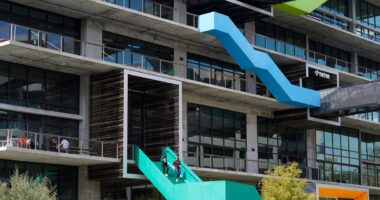NASA finally launched its Artemis 1 mission on November 16 and I was at Kennedy Space Center in Florida to watch.
The Space Launch System is Nasa’s biggest rocket ever and it has successfully shot the unmanned Orion capsule, which sat on top, on a 26-day mission around the Moon.
Watching a space launch is full of highs and lows.
Although the experience was ultimately worth it to watch history happen, viewing from Nasa’s press site can be an odd experience.
Staying awake for 30 hours
If you’re going to watch a rocket launch at Kennedy Space Center or on the outskirts, you probably won’t get much sleep.
Nasa asked journalists to arrive from 5pm ET (10pm GMT) on November 15 despite the rocket not launching until 1:47am ET (6:47am GMT) the following day.
It meant many journalists, astronauts and Nasa executives had to stay awake for a very long time to cover the launch and events that followed it.
Often people stay awake from the previous morning and work right through.
Members of the public wishing to view the launch from the surrounding area are told to get up and out early as the roads get blocked with traffic.
Most read in Tech
Keen rocket launch watchers should also be warned that Nasa commonly cancels launches unless everything is perfect.
Artemis 1 almost didn’t launch on November 16 because of an engine leak and loose screws.
An emergency team was able to enter the danger zone of the rocket and fix the screws in time but two previous Artemis 1 attempts were scrapped over similar problems.
Questionable food
Nasa advises people at the press site to bring their own food but sometimes it provides a food truck.
I went to Kennedy Space Center four times this year as the US space agency tried and failed to launch Artemis 1.
Almost every time the only food on offer was donuts, moon pies or grilled cheese sandwiches.
The included grilled cheese sandwiches being offered in the early hours of the morning.
Preparing to run for your life
Press and invited guests can view rocket launches right next to the Mission Control Center.
That’s the closest distance a human could be to the Artemis 1 rocket launch and remain safe.
The site is approximately three miles away.
Despite the big distance, journalists had to be prepared to run to a designated shelter spot should the rocket explode.
Risks from an exploding rocket include acid rain and debris.
Fortunately, Artemis 1 launched smoothly at 1:47am ET (6:47am GMT), just 43 minutes after the two-hour launch window opened.
Nasa Administrator Bill Nelson described the launch as the brightest he’d seen with the largest shockwave he’d experienced.
The blast-off was so bright I had to wear sunglasses and you can feel the force of the shockwave rattling through your body.
The brightness hits you first and the vibrations and sound come shortly after.
Nasa’s Space Launch System remained visible for a couple of minutes before disappearing into a tiny dot next to the Moon.
What is Artemis 1?
Artemis 1 isn’t a crewed mission but it needs to loop around the Moon to test three key components.
These are Nasa’s Space Launch System (SLS), its Orion spacecraft, and the European Service Module (ESM).
The Orion spacecraft and the ESM should get within 62 miles of the lunar surface and then travel 40,000 miles beyond this.
Once looping around the dark side of the Moon, the rocket should land in the Pacific Ocean off the coast of San Diego.
Nasa will keep a close eye on the Artemis 1 mission as it shoots away from Earth in case it still needs to be aborted.
Artemis 1 is important because it’s building up to Artemis 2, which will carry humans around the Moon in the next couple of years.
Both missions are building up to Artemis 3, which aims to put the first woman and the first person of color on the lunar surface.
Nasa says it has now started “a new chapter in human lunar exploration.”
















